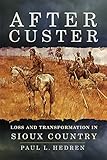 The Great Sioux War, which included the defeat of General Custer at the Little Big Horn, brought irreversible changes to the northern plains of the United States. In a few short years, Sioux Country and its buffalo herds was extinguished and replaced with railroads and prospectors and cattle and settlements named after the war's white combatants.
The Great Sioux War, which included the defeat of General Custer at the Little Big Horn, brought irreversible changes to the northern plains of the United States. In a few short years, Sioux Country and its buffalo herds was extinguished and replaced with railroads and prospectors and cattle and settlements named after the war's white combatants."I have attempted to expose the interconnectedness of it all: a war, the generals who came west in 1877 to bask in the accomplishments of their army, the forts they built to lock up a countryside and people, a new transcontinental railroad, the demise of the massive northern buffalo herd, the saga of the dynamic Beef Bonanza, the tribulations of the Lakota and Northern Cheyennes, and the army's substantial effort at memorialization," writes Paul L. Hedren in the preface to this historical geography of the northern Great Plains.
Hedren's assessment begins with the concluding battles of the Great Sioux War of 1876-77 and follows its consequences through the next two decades as the northern Great Plains is opened to settlement, the buffalo herds are replaced with cattle drives, soldiers are converted to reservation watchdogs, battlefields become memorial graveyards and newly created towns are named after the conflict's military leaders.
Loss and Transformation in Sioux Country
by Paul L. Hedren
University of Oklahoma Press, 2011.
Out of the Past: Battle of the Little Big Horn
Out of the Past
History and American West Titles
The Book Stall
Submit a Book for Review
Book List
Book Search
Book Store